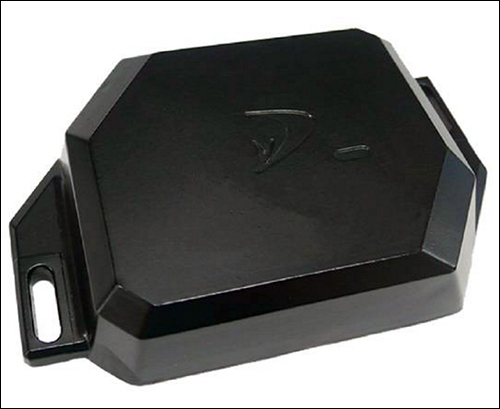Dynamox, a technology company in Florianopolis, Brazil, is marketing a new ultrahigh-frequency (UHF) RFID-enabled data logger that serves as a low-cost option for tracking goods in a cold supply chain using RFID sensors. The DynaLogger is a battery-powered UHF device that captures temperatures and humidity levels at preset intervals, or based on thresholds, and transmits all data related to those measurements when interrogated via RFID.
Dynamox was launched in 2007 as an automation technology provider for marine and logistics customers. In 2014, the company began developing RFID-based technology for tracking goods and vehicles, says Guillaume Barrault, Dynamox’s CEO and co-founder, and last year it teamed with semiconductor company EM Microelectronic to use its EM4325 RFID chips in its new data loggers. Barrault and Alexandre Ferreira co-founded the firm to use their electrical engineering backgrounds. Barrault has a Ph.D. degree in mechanical engineering and a master’s degree in ocean engineering.
The development of the data logger resulted from what the company felt was an absence of secure, low-cost options for unalterable sensors that could track both temperature and humidity levels. For instance, Barrault says, USB-enabled data loggers can store information that users can then access by plugging them into a computer device, but that data can potentially be changed.
If, for example, a logistics provider wanted to erase an indication that temperature or humidity levels had exceeded acceptable thresholds while products were in that company’s hands, it could simply change the sensor results in the computer records. Bluetooth-enabled data loggers allow the capturing of data in a mobile device, but the Bluetooth sensor would need to be physically turned on to operate properly, and the data might not be encrypted. RFID, on the other hand, allows data encryption—however, passive RFID systems without a battery would only provide sensor data collected at the time of an RFID interrogation. Active or battery-powered RFID sensors can be high in cost, Barrault adds.
Dynamox began designing an alternative in 2014—a low-cost, battery-powered UHF RFID system that could monitor sensor conditions based on moisture or temperature measurements linked to the device’s unique identifier, and accessible via an RFID reader. The company developed the solution to be flexible enough to operate in all parts of the world, so its antenna is compatible with E.U., U.S. and Brazilian standards.
The DynaLogger operates on a simple premise: collect data with the use of sensors and battery power, even when there is no RFID reader within the vicinity, then share that information once a reader interrogates the tag.
The data logger operates in three different modes, which a user can select. In the first, known as Mode 1, the logger can be set to capture temperature and moisture measurements at specific intervals, such as every five minutes, based on its internal clock. Each time the device performs a measurement, it stores that data on the chip, then returns to a dormant mode to conserve battery life. Based on the frequency of measurements, the company reports, the battery can last for approximately two years.
In Mode 3, the device can be set with high and low thresholds, such as the acceptable temperature range for a product being tracked. The logger then samples the sensor data at preset intervals and only stores the information if it determines that a threshold has been exceeded.
Mode 2 is a combination of Modes 1 and 3. In this mode, the device collects and stores data periodically, but only if a variant occurs, such as a temperature change of 2 degrees.
“I wouldn’t prescribe Mode 1 for most customers for two reasons,” Barrault says. Reading tags is faster in Mode 2 or 3 (less than one second) and the large amount of data being stored on the chip could be more than a logistics firm or a food or pharmaceutical company might want.
The technology company is currently in discussions with potential partners—solution providers whose software could manage the data for customers, such as food or drug companies that must ship their products in highly temperature- or humidity-controlled environments. Solution providers would offer their own cloud-based or integrated software for use with the sensor devices.
In a typical use case, Barrault says, a customer could place the data loggers in cartons or containers, or on pallets, then program the desired mode and temperature thresholds using software and a UHF RFID reader. The device measures about 9 centimeters by 6 centimeters (3.5 inches by 2.4 inches) and can be screwed onto a surface, affixed via adhesive or placed loose in a box.
Tags can be interrogated using handheld or fixed readers through typical plastic, wood or cardboard. The system can store 4,300 measurement samples with Mode 2 or 3, or 6,100 in Mode 1. The sampling interval can be programmed from every second to every 63 hours. In addition, the device can sample temperatures ranging from -40 degrees to +125 degrees Celsius (-40 degrees to +257 degrees Fahrenheit) with a resolution of about 1 degree.
Approximately 800 of the data loggers have been in testing since the technology was released in December 2016, according to Barrault. Dynamox is presently in conversations with several potential partners in Europe, South America and South Africa. “We believe the DynaLogger will be highly competitive in pricing,” he adds, estimating that it could be lower than $25 in high volumes.



